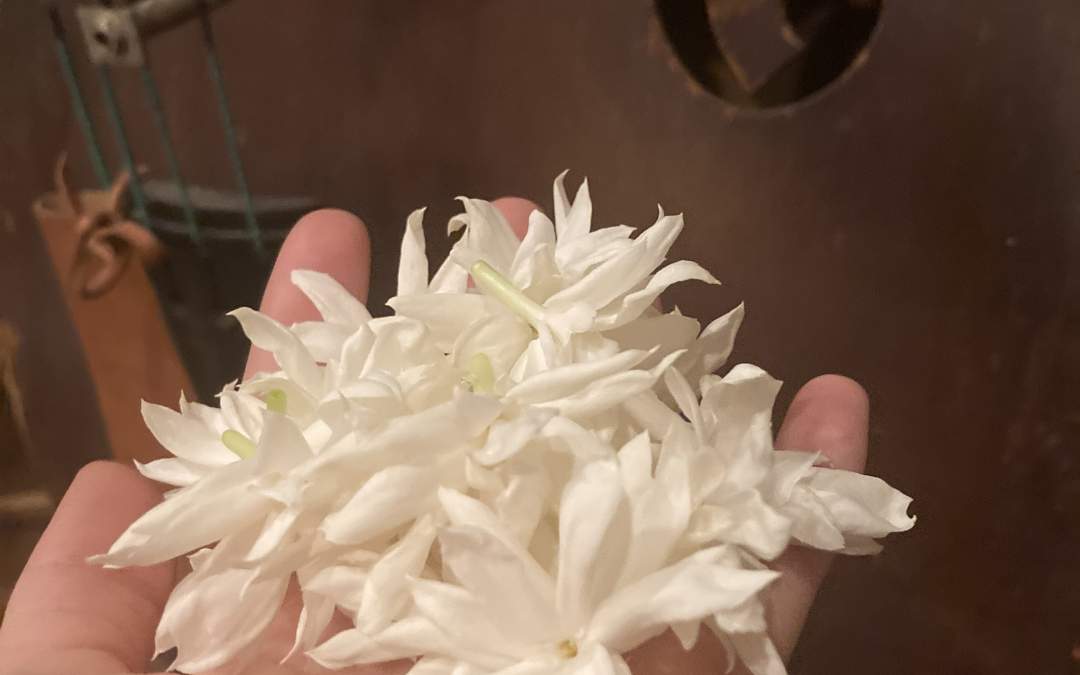
Take up space with Sambac Jasmine
I’ve been growing a Sambac Jasmine plant for about 3 years and this is the first year it’s really poppin’ off. I use an absolute of its flowers in one of my perfumes and it’s been such a pleasure living next to this plant, learning what it likes & watching it flourish. Sambac Jasmine starts blooming heavily in May in my region (9b) and sends its sweet, floral fragrance far & wide. It feels sensual, relaxing & uplifting at the same time. Here are a few facts & observations about Jasminum sambac:
In my yard: The variety that I have is like a mix between a shrub and a vine. It loves to sprawl out and send its branches in many directions, though it doesn’t send out tendrils. The flowers on my plant are double-layered. The last time I repotted it, it had spread its roots out of the pot and down into the tiny amount of soil available in my otherwise concrete yard. From its limbs to its roots to its big, loud, delicious fragrance, Sambac Jasmine is not afraid to take up space.
Plant names: Jasminum sambac, Sampaguita (Philipines), Melati Putih (Indonesia)
Elemental correspondences: Water + Earth
Family: Oleaceae (olive)
Native to: tropical Asia, from the Indian subcontinent to Southeast Asia. It’s the national flower of the Philippines and 1 of 3 national flowers of Indonesia. Widely cultivated in Southwest of Saudi Arabia, Yemen and Oman. Naturalized in many places, including Mauritius, Madagascar, the Maldives, Chiapas, Central America, southern Florida, the Bahamas, Cuba, Jamaica, and Puerto Rico.
Botany: Frost-tender evergreen vine or shrub; highly variable; ovate, simple leaves, either opposite or in whorls of 3. Blooms in clusters of 3-12. The flowers open at night and close in the morning.
Lore/traditional uses: In the Philippines, Sampaguita garlands are used as a form of bestowing honor, veneration, or accolade. Jasminum sambac is the subject of the danza song La Flor de Manila, composed by Dolores Paterno in 1879.
In Indonesian tradition, it has long been considered a sacred flower, as it symbolizes purity, sacredness, graceful simplicity and sincerity. It also represents the beauty of modesty; a small and simple white flower that can produce such sweet fragrance. The jasmine has wide spectrums in Indonesian traditions; it is the flower of life and beauty, yet it is also often associated with spirit and death.
Zones: 9-10
Scent profile: Sweet, creamy, floral, vanilla, fresh (like bath soap up close), lush, sweeter, more of a creamy floral from a distance, coumarin, indolic, lactonic; very diffusive (projects its scent far)
Energies & Aromatherapy: “Paradoxically strong yet serene, jasmine can settle and open the heart to self-love, compassion for others, and new experiences.” (from Aromatics International). Euphoric.
Elspeth’s Airs perfumes: Fleurs et chocolat*
*Fleurs et chocolat has been out of stock for a long time because I’ve been unable to find one of the essences (Tiare.) I’m currently growing both Tiare and Sambac Jasmine and enfleuraging them to hopefully use in perfumes again!

